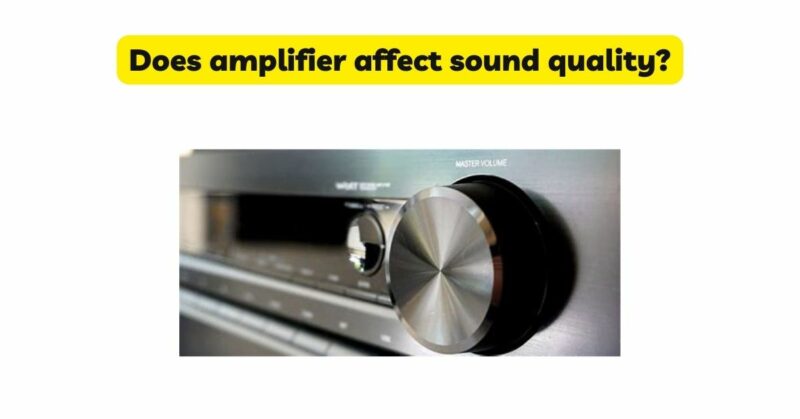Amplifiers play a pivotal role in shaping the sound of electric instruments, but how exactly do they affect sound quality? In this article, we delve into the intricate relationship between amplifiers and sound quality. We examine the various components and characteristics of amplifiers that can significantly impact the sonic output. By understanding the role of amplifiers in the signal chain, exploring amplifier types, examining circuitry and components, and considering factors like power output and speaker matching, we aim to shed light on the extent to which amplifiers influence sound quality.
I. Amplifiers in the Signal Chain
Amplifiers serve as a crucial link in the signal chain between your instrument and the final sound that reaches your ears. Here are the key aspects to consider:
- Gain and Preamp Section: The gain stage of an amplifier shapes the initial signal from your instrument. The preamp section of an amplifier determines the tonal characteristics, such as warmth, brightness, and saturation. Different amplifiers offer varying preamp designs, leading to distinct tonal signatures.
- Power Amp Section: The power amp section amplifies the preamp’s signal to a level suitable for driving speakers. It contributes to the overall character and responsiveness of the amplifier, affecting factors like headroom, dynamic range, and touch sensitivity.
- Speaker Cabinet: The speaker cabinet, coupled with the amplifier, influences sound projection, dispersion, and tonal characteristics. The cabinet’s design, speaker choice, and size all contribute to the final sound heard by the listener.
II. Amplifier Types and Sound Characteristics
Different amplifier types exhibit unique sonic characteristics, allowing players to choose an amplifier that aligns with their musical preferences. Consider the following amplifier types:
- Tube Amplifiers: Tube amplifiers are renowned for their warm, organic, and harmonically rich sound. They exhibit natural compression, smooth breakup, and a dynamic response that is highly responsive to playing nuances.
- Solid-State Amplifiers: Solid-state amplifiers employ transistors and integrated circuits for amplification. They often provide a clean, precise, and reliable sound reproduction with high headroom and transient response. Solid-state amplifiers are generally known for their accuracy and clarity.
- Digital Modeling Amplifiers: Digital modeling amplifiers use digital signal processing to emulate the sound characteristics of various amplifiers and effects. They offer a wide range of tones and versatility, allowing players to access different amplifier models and effects within a single unit.
III. Circuitry and Components
The circuitry and components of an amplifier significantly impact sound quality and overall performance. Here are key factors to consider:
- Amplifier Circuit Design: The amplifier’s circuit design, including the choice of components and topology, affects the overall tonal characteristics and sonic performance. Class-A, Class-AB, and Class-D amplifier designs, among others, each have their unique sonic signatures.
- Transformers: The quality of transformers used in amplifiers can influence sound quality. Transformers impact signal transfer, frequency response, and overall tonal balance. High-quality transformers can contribute to improved clarity and enhanced harmonic content.
- Capacitors and Resistors: The selection and quality of capacitors and resistors used in an amplifier’s circuitry can affect signal integrity, frequency response, and overall sound transparency. High-quality components contribute to better signal fidelity and reduced distortion.
IV. Power Output and Speaker Matching
The power output of an amplifier and its compatibility with speakers are critical factors in achieving optimal sound quality. Consider the following:
- Power Output: The power output of an amplifier determines its ability to drive speakers effectively. Insufficient power can lead to distortion, loss of clarity, and limited dynamic range. Choosing an amplifier with an appropriate power rating for your needs ensures optimal performance and sound quality.
- Speaker Impedance and Matching: Amplifiers and speakers must be properly matched in terms of impedance to achieve the best sonic results. Mismatched impedance can lead to a loss of power, compromised frequency response, and potential damage to the amplifier or speakers. Adhering to the manufacturer’s specifications for impedance matching is crucial.
Conclusion
Amplifiers play a vital role in shaping the sound quality of electric instruments. The type of amplifier, circuit design, choice of components, power output, and speaker matching all contribute to the overall sonic experience. Understanding these factors empowers musicians to make informed decisions when selecting an amplifier that suits their artistic vision and tonal preferences. Whether it’s the warmth and richness of a tube amplifier, the precision of a solid-state amp, or the versatility of digital modeling, each amplifier type offers unique sound characteristics. By exploring the intricate relationship between amplifiers and sound quality, musicians can make deliberate choices that enhance their playing experience and bring their musical visions to life. Remember that finding the perfect amplifier involves personal exploration and experimentation, as each player’s preferences and needs differ. Embrace the journey of discovering your ideal amplifier, and let its sonic influence inspire and elevate your music.


